As no machine sewing could done the whole of December, I prepared a couple of projects from SWAP batch 1 that required knitting which I did in the living room. First on the conveyor belt is Cowl-Neck A-line Sweater the Second.
 Cowl-Neck A-Line Sweater The First was a franken-patterned Burda 013-02-121. While it’s wearable, there’s room for improvements. Being a loose fitting top, the pattern had enough width to go around the bust. But obviously something isn’t quite right if the hem hitch up at the front, right? Simply adding width maybe isn’t the best way to accommodate a pseudo-D-cup. How do you well endowed ladies achieve a great fit with a dartless top?
Cowl-Neck A-Line Sweater The First was a franken-patterned Burda 013-02-121. While it’s wearable, there’s room for improvements. Being a loose fitting top, the pattern had enough width to go around the bust. But obviously something isn’t quite right if the hem hitch up at the front, right? Simply adding width maybe isn’t the best way to accommodate a pseudo-D-cup. How do you well endowed ladies achieve a great fit with a dartless top?
Anyway, being too impatient to wait for your advice (still welcome if you have any), I decided to experiment drafting my own dartless top pattern. And being a control freak I wanted to find some logic to hiding the darts rather than just haphazardly redraw the seam lines without the darts.
The Tunic Block experiment:
 The most obvious option is to pivot all the dart allowances into a massive unsewn waist dart. But surely that would result in a tent, which might be fine in limp drapy fabric, but not so great in the lofty sweater-like mohair gauze I’m using for the sweater.
The most obvious option is to pivot all the dart allowances into a massive unsewn waist dart. But surely that would result in a tent, which might be fine in limp drapy fabric, but not so great in the lofty sweater-like mohair gauze I’m using for the sweater.
 I checked all the pattern drafting books I have for other options, but found no definitive answer. The closest I got was this page in Bunka Fundamentals of Garment Design text book. I tried a variation of this, but distributed the dart allowances in more places to ensure that none are too big. So did it work? Let’s see shall we?
I checked all the pattern drafting books I have for other options, but found no definitive answer. The closest I got was this page in Bunka Fundamentals of Garment Design text book. I tried a variation of this, but distributed the dart allowances in more places to ensure that none are too big. So did it work? Let’s see shall we?
The Muslin Mug Shots:
Hm, why do muslin photos always come out worse than it looks in the mirror? I was quite pleased with the muslin before these photos. Now I hear the sirens calling tweaks. But I’ve had enough for now.
 Despite the minor imperfections I think this is good enough to turn into a wearable muslin, something a bit like the Burdastyle 013-02-121 Flared Tunic that I used for Cowl-Neck A-line Sweater the First.
Despite the minor imperfections I think this is good enough to turn into a wearable muslin, something a bit like the Burdastyle 013-02-121 Flared Tunic that I used for Cowl-Neck A-line Sweater the First.
The fabric is from Tia Knight, which mainly sells stretch fabrics. I took a chance on this non-stretch linen woven & was a bit disappointed. The color didn’t quite match the picture on their website, so it was a bit blah. But with the right trims maybe it’ll look suitably Moroccan-inspired & holiday ready. I even added enough seam allowance in the sleeves to go casually bell shape.
The Block & How It’s Made:
Bodice:
- Taking my Fitted Top/Dress Block, I pivoted the side front dart into a little bit of ease in the neck (3/8″), shoulder (3/8″), armhole (1/2″), side seam (3/8″), and the remainder in the unsewn waist dart. I chose the amounts based on how much I think I can ease in at seams & hems without puckering or too much gaping. The back dart allowances are simply left unsewn (waist darts) or eased into the seam (shoulder dart).
- Before making a muslin, I also adjusted the side seam to get the Tunic silhouette I wanted, which is somewhat fitted through the bust, then flared from the under-bust down. I worried that flaring right from the armpit would result in a frumpy look on my non-modelesque figure. And to avoid a pregnant look I reduced the front flare at the side seam, but took care to ensure it doesn’t go into negative ease territory by comparing it to the 0-ease Moulage at High Hip & Hip.
- Next up was the muslin which looked pretty good (sorry forgot to take pictures). There was no bust drag lines, my guidelines all looked straight and level, the front wasn’t hiking up like in the Franken pattern. But of coursfe I couldn’t leave well alone.
- Having ease in both front & back shoulder basically cancelled each other out, resulting in an unintentionally slightly too wide shoulder. I considered using stay tape, but ended up removing the front shoulder ease at the armscye. I find that the combination of too much cross-front width plus a somewhat fitted sleeve tends to restrict my forward arm movement.
- The underarm seem to have been lowered by all the front dart pivoting, so I raised it slightly (1/4″) & also shorten slightly at shoulder seam (1/8″ each, 1/4″ total).
- At the side seams I found I could comfortably reduce the circumference in the under-arm to under-bust area a tiny bit further for a slimmer fit (3/16″ each seam, 3/4″ total). The A-line silhouette was a bit too subtle, so I also flare out the hem a little bit more from under-bust to under-bum (1/2″).
Sleeve:
- Converted my Elbow Dart Fitted Sleeve Block to Basic Fitted Sleeve Block (no elbow dart):
 The cap curve is the same, but below the bicep line I made the sleeve front & back symmetrical (as instructed in most pattern drafting books, I’m using Designing Apparel through the Flat Pattern).
The cap curve is the same, but below the bicep line I made the sleeve front & back symmetrical (as instructed in most pattern drafting books, I’m using Designing Apparel through the Flat Pattern).- I also marked a wider wrist because the original was sized for my relatively skinny wrists, but it’s a bit tight for my normal sized hands to go through when dressing/undressing.
- I made no alteration for my “Posterior Arm Joint” & “Inward Rotation of Elbow” like the original sleeve block because…erm, I couldn’t figure out how when there’s no elbow dart to ensure front & back sleeve seam match in length. I just prayed that the extra ease at the wrist accommodate the wonkiness of my arms!
- Convert the new Basic Fitted Sleeve Block into a more relaxed fitting Tunic Sleeve Block:
- Removed the cap ease by lowing the cap height slightly & redraw the top bit of the cap curve
 Convert to a shallower cap by moving the bicep line up (reduced cap height by 1-1/4″); pivot at shoulder seam crossmark so the armsyce slopes to the new bicep line (bicep ease increased from 1-1/4″ to 2-3/4″); remeasured sleeve length at traced center line; square out at wrist level & cross-marked wrist width (same width as on my new Basic Fitted Sleeve Block); connect new armscye end points to wrist width cross-marks. BTW, my shallower tunic cap height is still closer to the Medium cap height calculated using the generic cap height formula mentioned in Dennic Chunman Lo’s Patternmaking: Portfolio Skills. The same formula would make my fitted sleeves are closer to a High cap height. The formula is basically AH/4 for Medium, then +”1-1/2″ ~ 2-1/4″ for High or -1-1/2″ ~ 2-1/4″ for Low.
Convert to a shallower cap by moving the bicep line up (reduced cap height by 1-1/4″); pivot at shoulder seam crossmark so the armsyce slopes to the new bicep line (bicep ease increased from 1-1/4″ to 2-3/4″); remeasured sleeve length at traced center line; square out at wrist level & cross-marked wrist width (same width as on my new Basic Fitted Sleeve Block); connect new armscye end points to wrist width cross-marks. BTW, my shallower tunic cap height is still closer to the Medium cap height calculated using the generic cap height formula mentioned in Dennic Chunman Lo’s Patternmaking: Portfolio Skills. The same formula would make my fitted sleeves are closer to a High cap height. The formula is basically AH/4 for Medium, then +”1-1/2″ ~ 2-1/4″ for High or -1-1/2″ ~ 2-1/4″ for Low.- For the wearable muslin tunic’s bell shape sleeve I added 7″ to wrist width (3-1/2″ at front & back), but connect this to the original sleeve seam at about mid upper arm in the hope of keeping the arm looking slimish.
The Verdict:
Good enough for now but no cigar. I need to look into…
- Why the tunic want to tilt towards the back at the neck, creating that dread bust dragline, higher front hem, lower back pooling. Making the back neckline more shallow doesn’t help. Maybe I have rounded upper back problem requiring more shaping there to keep the upper back in place?
- If the sleeve setting can be improved. Not sure if draglines in the front & back is natural for a shallower cap or if the pitch is not quite right, or maybe I do also need some sort of “Posterior Arm Joint” & “Inward Rotation of Elbow” adjustments for dartless sleeves.
Now a note in case you’re well endowed and want to try the experiment too…I’m not really a D-cup. But maybe because my arm joints seem to be set further towards the back, my front bodice sloper’s bust darts are closest in size to Vogue 1004 Fitting Shell’s D-cup pattern (in size 8 – my old size – rather than the size 12 the sizing charts would have me buy). If I connect the bust darts to the bust point, measure & add up the side & waist darts, the total angle measures about 57º. If you’re super well endowed, it may be that you need a dart to achieve the best looking shape. But maybe this approach can still give you a more relaxed fit without totally obscuring your figure.
Next up: Cowl-Neck A-line Sweater the Second proper.
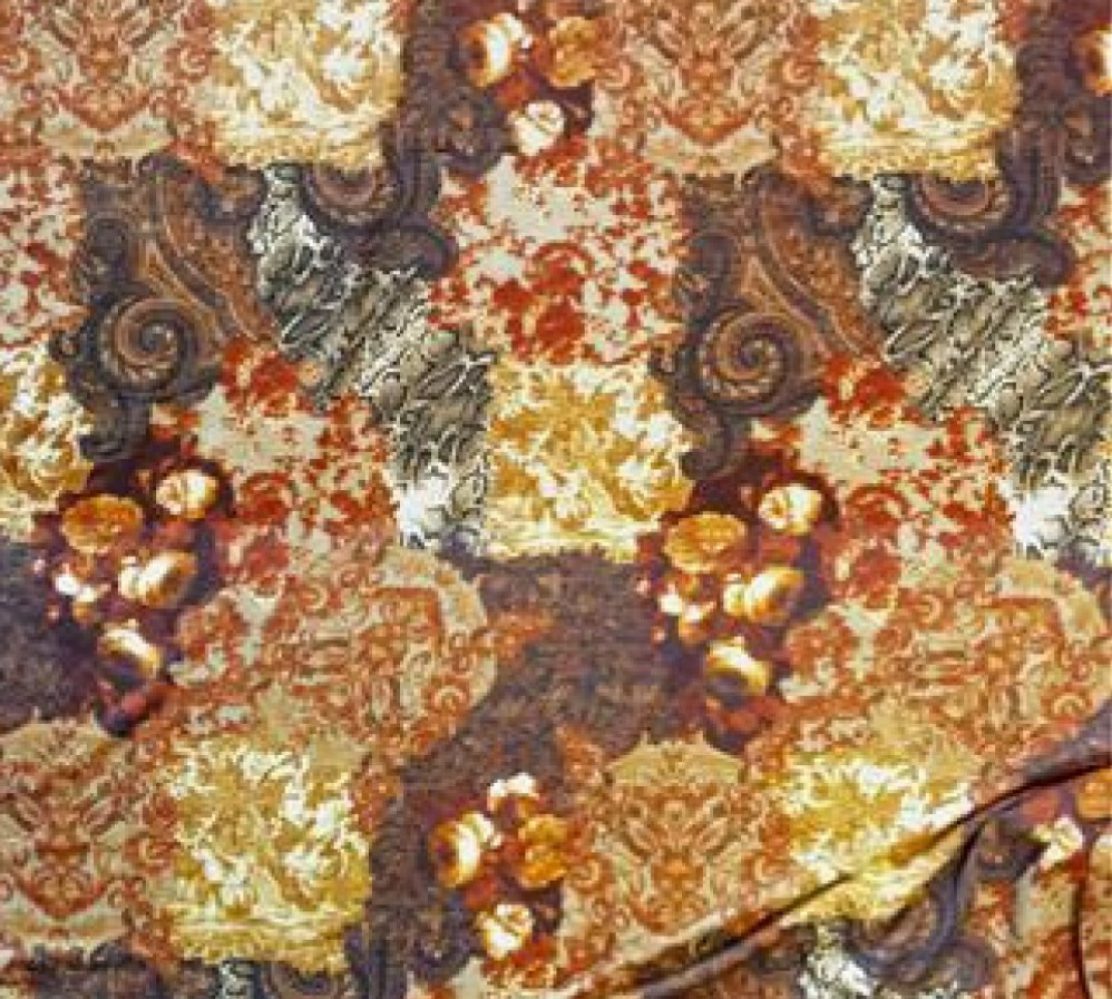
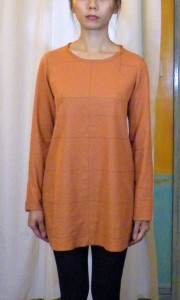
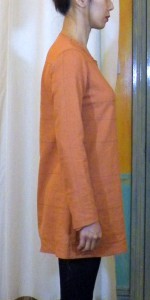
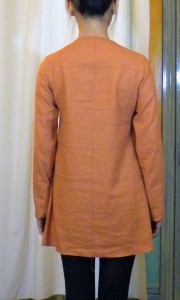
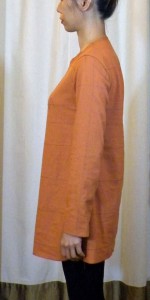
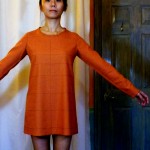
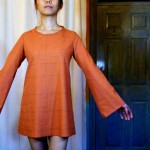
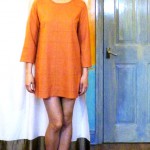
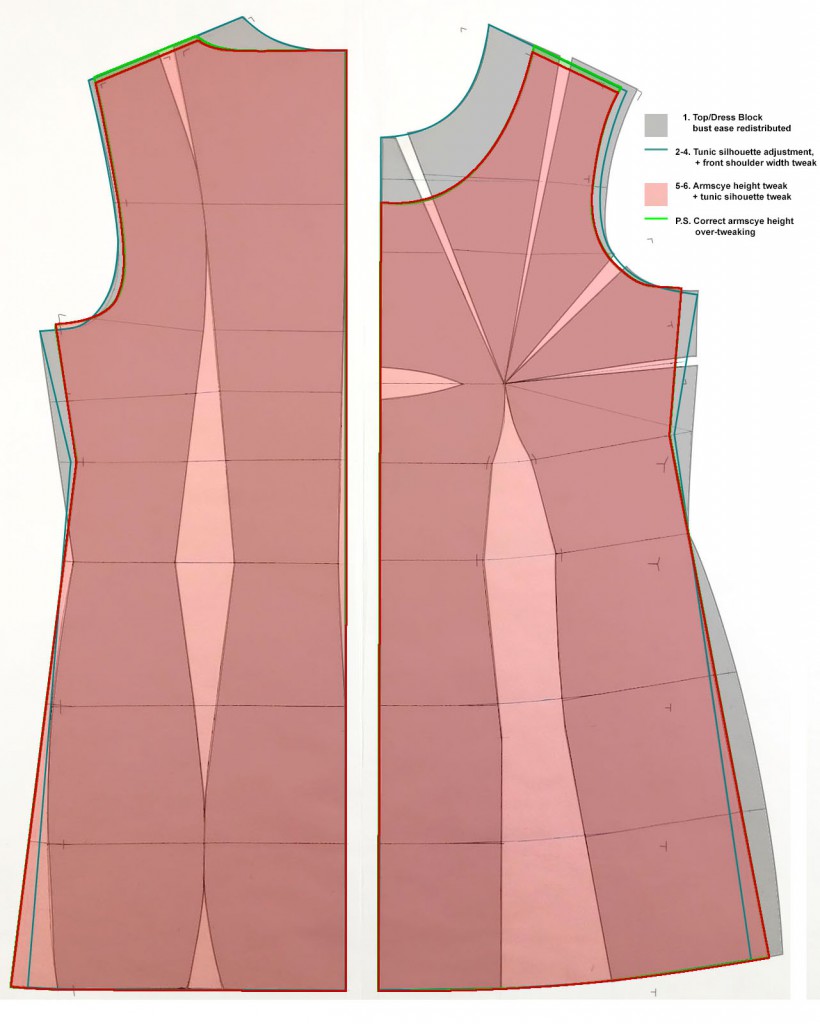
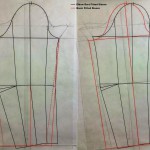
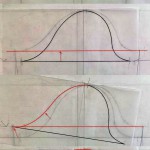
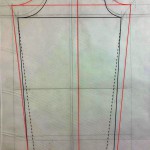
I’m over my depths in this discussion so won’t presume to offer fit advice. Looking forward to seeing the cowl neck Mark II though. Your muslin looked very promising , especially from the front. I’ve always steered away from A-lines full stop as I equate them with frumpy, at least pour moi, I think that one has to wary of them if over a C cup… I definitely think they are more suited to those with a more petite bust.
A-lines…I see what you mean about whether it suits C+ busts. A more rounded / wider full bust maybe would interfere with this silhouette, so doesn’t work so well. I guess my pseudo-D is more forward, so from the front at least the girls don’t disrupt the silhouette much. But the side view isn’t so flattering, especially if the length is shorter (too tubby). I think in this longer below bum length I can just about get away with it.
It’s all about the whole person proportion & silhouette me thinks. I’m sure I have come across well endowed women wearing A-line-ish garment and looking great. Perhaps it just about finding the right version of the A-line – where it flares from, how long it flares for, how much flare & how drapy or not.
Ah, going down the rabbit hole with Kopp and Lo. I was just pondering how much I love those books, and how much trouble they have led me into.
It looks at this angle as if you have too much width in the sleeve cap. Shortening it that much seems to make the sleeve want to stick out straight (does it feel bunched up under your arm?). The torso looks great.
As for the dartless challenge, there’s always cutting it on the bias…….with raglan sleeves (I suppose that is sort of like using a dart…..).
Do you mean too much sleeve cap length? Or do you actually mean the width across the sleeve cap parallel to the bicep say halfway up or from notch to notch? The shallow sleeve cap length is intentional – I’m working my way towards a T-shape kimono block & shirt block eventually. I just don’t know how these causal shallow cap sleeves are suppose to look when done right. I know there will be more drape underarm. But how does one tell the intentional drape apart from poor fitting draglines? I don’t want to end up with another fitted sleeve with limited arm movement.
Have you tried dartless top cut on the bias? Does it fit better?
I actually had the best luck with draping in this type of situation, I got a much better fit, even with a d cup. According to the draping book I own, you can actually adjust a lot of the flare through the shoulder angle. You also have to curve the armhole more while lengthening and widening the front. Those are some of the things I’ve encountered, I haven’t thoroughly researched it yet.
Which draping book are you using? I’m curious about this controlling the flare through shoulder angle. Have you tried it? Does it work?
The curing the armhole + lengthening & widening the front sounds like option 1 (pivot dart allowance into waist dart). Or have I misunderstood what you wrote?
Do you have pictures of larger cut dartless tops that you’ve made through draping? Would love to see what fit & silhouette is possible.
Gosh, Pia, the muslin looks really good. And I know what you mean about muslins looking a hell of a lot worse in pics that in real life.
I am not a fit expert like you (you’re well on the way to becoming one!), but I’m wondering if the back needs the ease (drag lines) so you can hug yourself. When I look at couture garments, there always seems to be a lot more ease than we sewistas think is appropriate. Our culture thinks fitted = tight, but in woven garments at the haute couture level, I don’t see a lot of tight. What I do see is a tremendous amount of ease… to the point where most people (sewers and otherwise) would say the garment was too big. Just something that keeps percolating in the back of my sewing/fitting head….
And I do think, after Mrs. Mole’s advice to me on my blue Burda disaster, that your sleeve cap needs to be a teensy bit higher to remove those drag lines. Could you slash and spread and then redraft? Love the bell sleeve, btw.
As for the higher-in-front hemline… I have very few thoughts that may be helpful. I am truly a D+ cup, and darts are never an option for me in a woven. I just can’t get around it no way no how. (I can just get away with it in a knit, but it’s far from a perfect fit). My first instinct, looking at your pics, would be to add depth over the bust point to keep the grainline horizontal around the garment. But how do to that without adding a dart is something I’d have to play with, and therefore, I cannot give definitive advice.
Interesting point about “couture” fit. I too sometimes feel disappointed looking at famous couture (& designer) garments in museums. Some of them look rather frumpy to me. As you said, almost as if they’re too big. Maybe they were made for taller (therefore bigger) women. Maybe I have unrealistic expectations. Photoshop has a lot to answer for! Then there are “couture” that aren’t my normal definition of “couture” – the word seems to be thrown around quite liberally nowadays.
The sleeve…I think I need to examine more examples of casual (shallow cap) sleeves and how they drape. I’m reluctant to increase the cap height precisely because this is meant to be a more casual sleeve. Most of the fitting advice seems to be demonstrated for more formal fitted sleeves. I don’t want the tunic sleeve to end up fitting like a suit with limited arm movement!
Bust…with knit do you generally forgo the dart? I’m working on a knit sloper using instruction from the defunct Stretch Pattern School. Even though the instruction is for bathing suits – so high stretch fabric – the block still has bust dart. I’ve done a muslin now and the fit is great with a dart. But because everyone seems to be wearing dartless knit tops I’m tempted to forgo the dart. So should I stick to mountain goat ways?